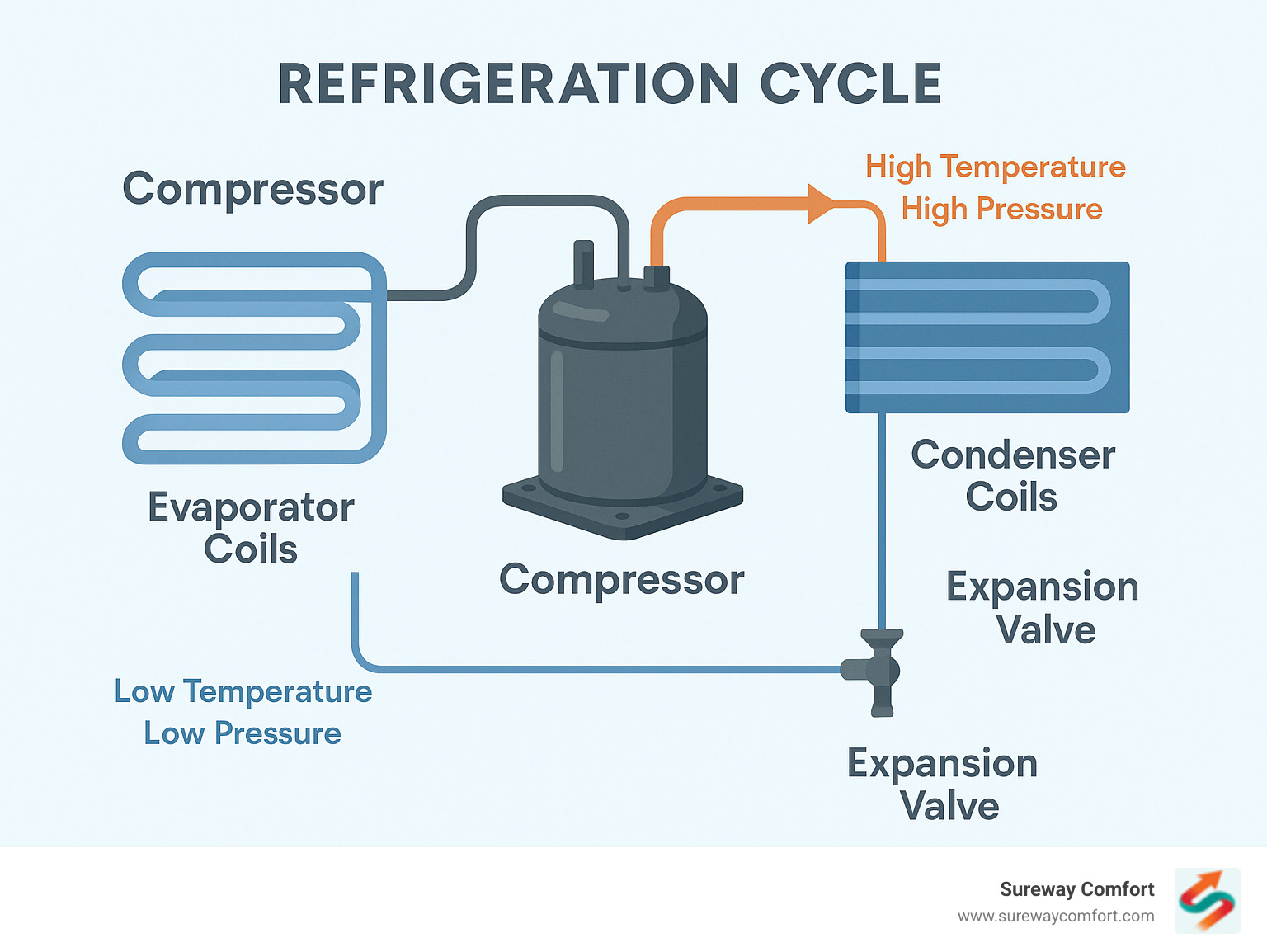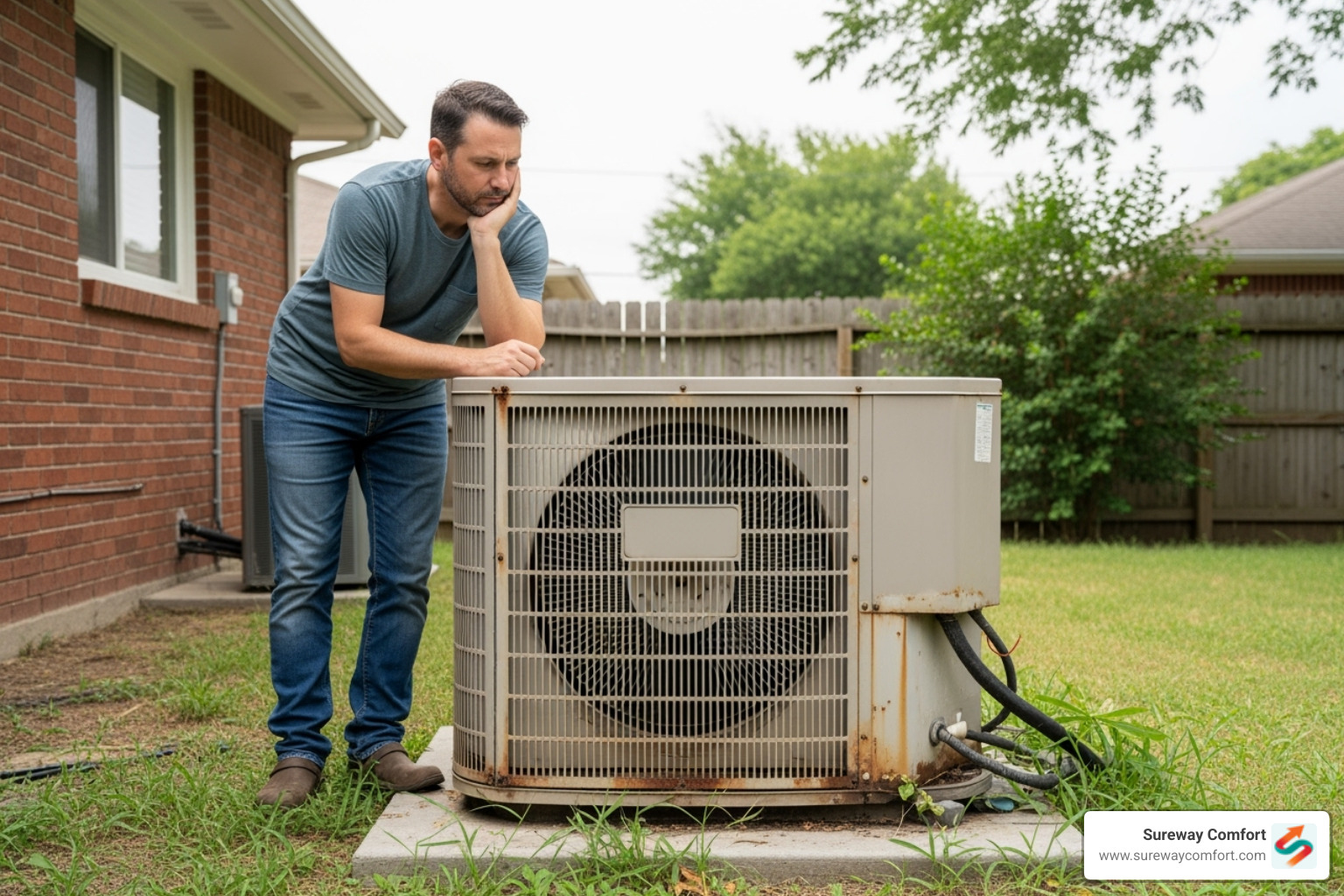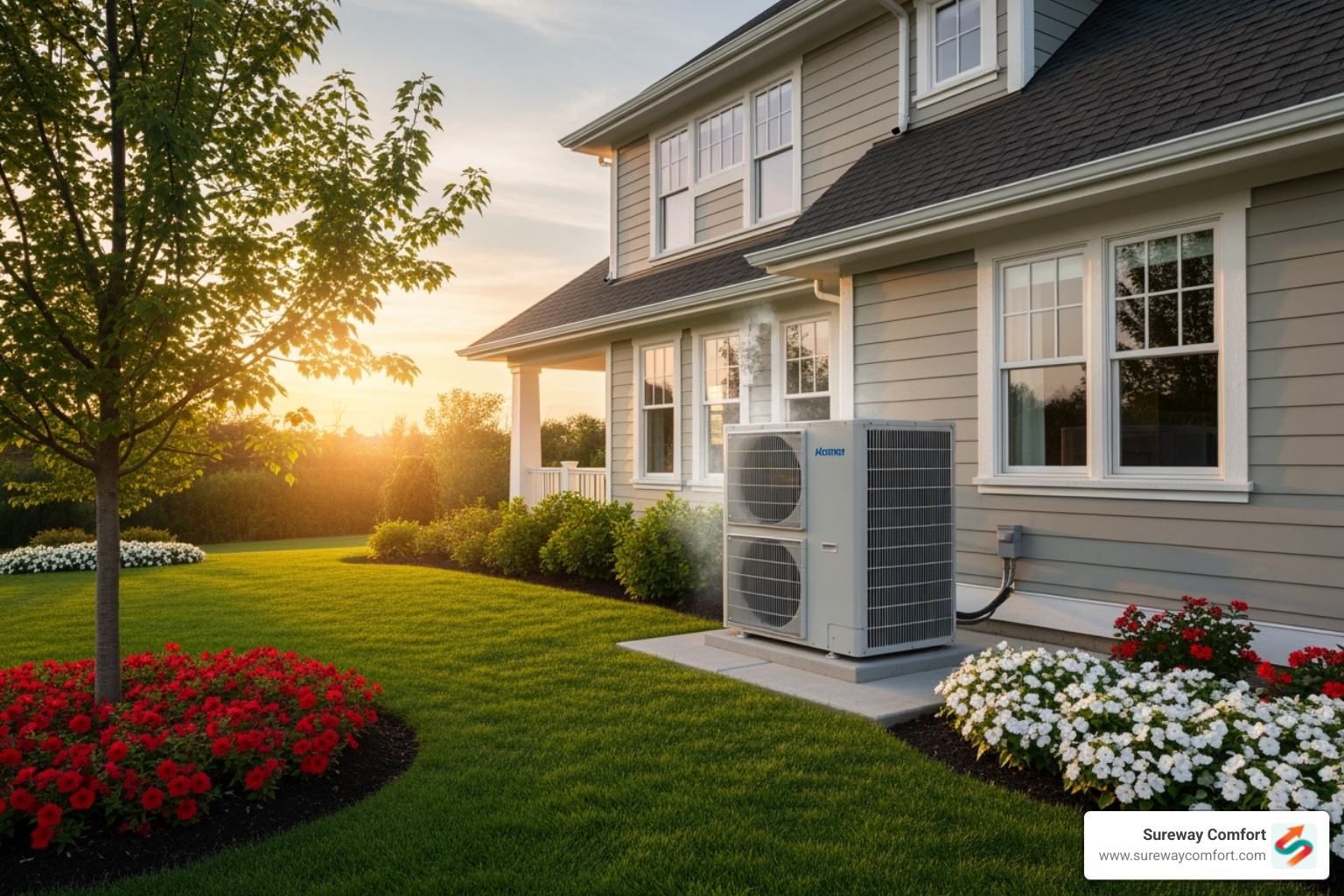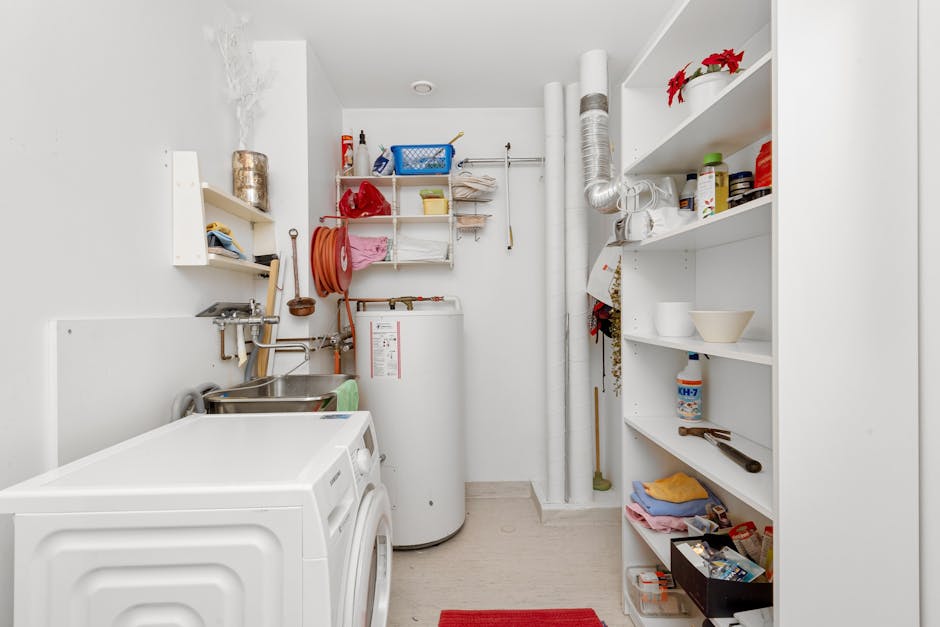The Heart of Your Cooling System
AC compressor repair is one of the most critical HVAC services homeowners need, especially during Pittsburgh's humid summers. Your AC compressor acts as the heart of your cooling system, circulating refrigerant and making the entire air conditioning process possible.
Quick AC Compressor Repair Guide:
- Check power first - Verify circuit breakers and thermostat settings
- Listen for sounds - Grinding, squealing, or clicking noises indicate problems
- Look for leaks - Oil stains or moisture around the unit suggest refrigerant issues
- Test cooling - Warm air from vents often means compressor failure
- Call professionals - Refrigerant work requires EPA certification and special tools
The compressor works by compressing refrigerant gas, which then flows through your system's coils to absorb heat from inside your home and release it outside. When this crucial component fails, your entire AC system stops working effectively.
According to industry data, replacing an AC compressor averages $1,600, while a complete outdoor unit replacement costs around $1,800. These significant expenses make proper diagnosis essential before jumping into repairs.
Most AC compressors last 10-15 years with proper maintenance, but several factors can cause premature failure. Low refrigerant levels, electrical problems, dirty coils, and lack of lubrication top the list of common culprits.
Understanding your compressor's role helps you spot problems early and make smart repair decisions. Whether you're dealing with strange noises, reduced cooling, or complete system failure, knowing the basics can save you time and money.

Is Your AC Compressor Failing? Common Signs and Causes
A failing AC compressor often gives warning signs before it quits completely. Recognizing these symptoms can help you address the problem before it gets worse. Key indicators include:
- Warm Air From Vents: If your AC is running but not cooling, the compressor may not be circulating refrigerant properly.
- Strange Noises: Grinding, squealing, or clattering sounds from the outdoor unit can indicate worn-out internal parts or bearing problems.
- Frequent On/Off Cycling: If the compressor turns on and off every few minutes without finishing a cooling cycle, it's "short cycling." This often points to low refrigerant or electrical issues.
- Tripped Circuit Breaker: A compressor that's working too hard can draw excess power, tripping the breaker as a safety measure.
- Moisture or Oil Leaks: While some condensation is normal, puddles of water or oily residue around the outdoor unit can signal a refrigerant leak or failing seals.

Several issues can lead to compressor failure, requiring professional AC compressor repair:
- Low Refrigerant: Leaks cause the compressor to overwork and overheat. Since refrigerant carries oil, low levels also mean poor lubrication.
- Electrical Faults: Bad capacitors, worn contactors, or faulty wiring can prevent the compressor from starting or running correctly.
- Dirty Condenser Coils: When outdoor coils are clogged with dirt and debris, they can't release heat, trapping heat and pressure in the system.
- Blocked Refrigerant Lines: Obstructions in the suction lines force the compressor motor to work harder.
- Contaminants: Dirt, leaves, and other debris entering the system can cause blockages and damage internal components.
Signs of a Faulty AC Compressor Clutch
The compressor clutch connects the compressor to its motor. If it fails, you might notice:
- Clutch Not Engaging: The center plate on the compressor's pulley should spin when the AC is on. If it doesn't, the clutch is likely the problem.
- Unusual Noises: A loud squeal when the clutch tries to engage or a constant rattle can indicate a worn or loose clutch.
- Intermittent Cooling: If your AC cycles between cool and warm air, a faulty clutch could be the cause.
How Other System Issues Impact the Compressor
Your compressor's health depends on the entire HVAC system. Problems elsewhere can cause it to fail:
- Faulty Capacitors & Contactors: These electrical parts help the compressor start and run. When they fail, the compressor can struggle, overheat, or fail to start.
- Thermostat Problems: A malfunctioning thermostat can send incorrect signals, causing the compressor to run too much or not at all.
- Dirty Coils & Filters: Dirty evaporator coils or clogged air filters restrict airflow, forcing the entire system to work harder. The environmental impact of refrigerant leaks is also a major concern, as these are potent greenhouse gases requiring professional handling.
DIY Diagnosis and Basic AC Compressor Repair Steps
While most AC compressor repair jobs require a professional, you can perform some basic diagnostic checks to identify the problem. This information can be very helpful when you call for service.

Safety First: Before inspecting your AC unit, always turn off the power at two locations: your thermostat and the main circuit breaker for the air conditioner. This is crucial for your safety.
Checking the Basics: Power and Settings
Sometimes the fix is simpler than you think. Before assuming the worst, check these fundamentals:
- Thermostat: First, ensure it's set to "Cool" and the temperature is set several degrees below the current room temperature. Also, check that the fan is set to "Auto," not "On."
- Circuit Breaker: Find your home's electrical panel and locate the breaker for the AC. If it has tripped (usually in the middle or "off" position), try resetting it once by pushing it fully to "off" and then back to "on." If it trips again, leave it off and call a professional, as this indicates a serious electrical problem.
- Disconnect Box: Many outdoor units have a separate power disconnect box nearby, which may contain fuses. With the power off at the main panel, you can check these fuses for any signs of being blown (blackened glass or a broken filament).
Initial Checks at the Outdoor Unit
After confirming the basics, you can carefully observe the outdoor unit for more clues:
- Listen for Sounds: A normal unit produces a low hum. Grinding, squealing, or loud clicking noises are red flags for mechanical trouble. A hum followed by a click and silence often points to a startup problem, possibly with the capacitor.
- Clear Debris: Your outdoor unit needs to breathe. Ensure there are at least two feet of clearance around the unit, and remove any leaves, grass clippings, or other debris that could be blocking the condenser coils.
- Observe the Fan: When the AC is running, the large fan on top of the unit should be spinning steadily. If it's not moving or is sluggish, the fan motor may have failed, which can cause the compressor to overheat.
- Look for Ice: Ice on the copper refrigerant lines is a clear sign of a problem, typically low refrigerant or restricted airflow from a dirty filter or evaporator coil. This puts significant strain on the compressor.
The Big Decision: Repair or Replace?
When faced with a major AC compressor repair, homeowners often wonder if it's better to fix the old unit or invest in a new one. The answer depends on several key factors, and making the right choice can save you money and headaches in the long run.

Key Factors to Consider
- Age of the Unit: Most air conditioners last 10-15 years. If your unit is over 10 years old, a costly compressor repair may not be a wise investment, as other components are likely nearing the end of their lifespan.
- Warranty Status: Check if your compressor is still under warranty. A manufacturer's warranty can significantly reduce the cost of repair, making it a more attractive option.
- Energy Efficiency (SEER Rating): Older units have low SEER (Seasonal Energy Efficiency Ratio) ratings and cost more to operate. A new, high-efficiency system can lead to substantial savings on your monthly energy bills, helping to offset the initial investment.
- Overall System Condition: Consider the health of your entire HVAC system. If the indoor coil and furnace are also old, replacing only the outdoor unit can lead to a mismatched system with poor performance and efficiency.
The Cost of AC Compressor Repair vs. Full System Replacement
The financial breakdown is a critical part of the decision. While a repair has a lower upfront cost, a replacement often provides better long-term value.
OptionAverage CostWarranty (Typical)Long-Term BenefitsAC Compressor Repair$1,200 - $2,0001-2 years on partsRestores current system function; lowest upfront cost; keeps existing SEER ratingOutdoor Unit Replacement$1,800 - $4,0005-10 yearsImproved efficiency with new condenser; better reliability; may require indoor coil matchingComplete System Replacement$3,500 - $8,0005-10 years full systemMaximum efficiency gains; matched components; latest technology; lowest long-term operating costs
Should I Replace Just the Compressor or the Whole Unit?
This is a common question, and in most cases involving an older system, replacing the entire system is the smarter choice.
- Mismatched Systems: A new, high-efficiency outdoor unit paired with an old indoor coil will not achieve its advertised SEER rating and can suffer from premature failure due to incompatibility.
- Refrigerant Type: Older systems often use R-22 refrigerant, which is being phased out and is very expensive. New systems use the more efficient and environmentally friendly R-410A. Upgrading your whole system avoids the high cost and scarcity of R-22.
- Long-Term Reliability: A complete system replacement ensures all components are new, designed to work together, and covered by a comprehensive warranty. This prevents the "domino effect" of one old part failing after another, saving you from repeated repair bills.
If your system is over 10 years old and needs a new compressor, replacing the entire system is almost always the most cost-effective and reliable solution for long-term comfort.
Is Your AC Compressor Failing? Common Signs and Causes
When your AC unit isn't performing its best, the compressor is often the prime suspect. Recognizing the signs early can prevent more extensive damage and help you decide on the best course of action for AC compressor repair.
Here are some common symptoms that your AC compressor might be failing:
- Warm Air from Vents: If your AC is running but blowing air that isn't cold, it's a strong indicator that the compressor isn't circulating refrigerant effectively.
- Strange Noises: Unusual sounds like grinding, squealing, clattering, buzzing, or humming from your outdoor unit could signal internal damage. A high-pitched squeal often points to bearing issues, while clattering might mean loose internal components.
- Frequent Cycling: If your AC compressor kicks on and off rapidly without completing a full cooling cycle, it's called short cycling. This can be caused by low refrigerant levels, electrical problems, or a faulty cycling switch.
- Tripped Circuit Breaker: A compressor that's struggling or drawing too much power can trip your home's circuit breaker.
- Moisture Leaks: While some condensation is normal, excessive moisture or leaks around your outdoor unit, especially if accompanied by oil, can indicate failing seals or components.
Several factors can lead to the need for AC compressor repair:
- Low Refrigerant Levels: Leaks in the refrigerant lines cause the compressor to work harder, overheat, and eventually malfunction. It also means low lubrication oil, leading to dry running and seizing.
- Electrical Faults: Issues like a faulty start capacitor, worn contactors, loose wiring, or a failing pressure switch can disrupt electrical flow, causing the compressor motor to struggle or not start.
- Dirty Condenser Coils: If coils are caked with dirt, heat transfer is inhibited. This forces the compressor to run constantly, building up excessive pressure and heat.
- Clogged Suction Lines: Blockages in the refrigerant lines hinder refrigerant movement, reducing cooling capacity and putting immense strain on the compressor motor.
- Overheating: Dirty coils, low refrigerant, or continuous operation in hot climates can cause the compressor to overheat.
- Lack of Lubrication: The compressor requires proper lubrication. If the system is low on refrigerant, it's often also low on oil, leading to increased friction and wear.
- Contaminants: Dirt, dust, insects, leaves, and fungi can enter the external compressor unit, causing malfunctions.
- Incorrect Refrigerant: Using the wrong type or overfilling can create excessively high pressure, straining the compressor.
The environmental implications of refrigerant leaks are significant. Refrigerants are potent greenhouse gases, which is why proper handling and repair by certified professionals are legally required.
Signs of a Faulty AC Compressor Clutch
The AC compressor clutch connects the compressor to the motor. If this clutch isn't working right, your compressor won't either:
- Clutch Not Engaging: The center plate of the pulley should spin when the AC is on. If it's not spinning, or spins intermittently, the clutch might be faulty.
- Visual Inspection: Look for signs of wear, burning, or damage on the clutch assembly.
- Noises: You might hear a loud squeal when the clutch tries to engage, or a persistent rattling if the clutch is loose or worn.
- Intermittent Cooling: If your AC blows cold air sometimes, then switches to warm air, an intermittently engaging clutch could be the culprit.
How Electrical and System Issues Impact the Compressor
The compressor relies on a healthy electrical supply and proper system conditions:
- Faulty Capacitors: Capacitors provide the necessary jolt to start the compressor motor. If failing, the compressor may hum but not start, or struggle to run.
- Worn Contactors: These switches control electricity flow to the compressor. A worn contactor can lead to poor electrical connection.
- Thermostat Role: If malfunctioning, it might send incorrect signals to the compressor, causing it to run unnecessarily or not turn on.
- Dirty Evaporator Coils: If these coils are dirty or frozen, they can't absorb heat efficiently, causing the compressor to overwork.
- Reduced Airflow: Any blockage in your system, from dirty air filters to clogged ducts, makes the entire system work harder, leading to increased wear.
DIY Diagnosis and Basic AC Compressor Repair Steps
We understand the urge to troubleshoot a problem yourself, especially when you're sweltering in the summer heat! While complex AC compressor repair should always be left to the professionals, there are some basic diagnostic steps you can take to understand the issue better before calling us. This can save you time and money by helping us pinpoint the problem faster.
First and foremost, safety precautions are paramount. Your AC system operates with high voltage electricity and contains refrigerants under pressure. Never attempt any repair that involves opening sealed refrigerant lines or dealing with high-voltage wiring if you're not trained and certified. Always start by turning off the power to your AC unit at the thermostat and, crucially, at the circuit breaker box. Locate your circuit breaker box (usually found on the outside of your home or in a utility closet) and flip the switch for your AC unit (often labeled "AC" or "Furnace") to the "off" position. This ensures no electricity is flowing to the unit while you're inspecting it.
Once the power is off, you can begin some basic troubleshooting and visual inspection:
Checking the Basics: Thermostat and Power Supply
Let's start with the simplest things first – it's amazing how often a quick check here solves the problem!
- Thermostat Settings:
- Is your thermostat set to "cool" mode?
- Is the temperature setting lower than the current room temperature? Sometimes, we just forget to adjust it after a cool spell.
- Is the fan setting on "auto" or "on"? If it's on "on," the fan might blow air even if the compressor isn't running.
- Circuit Breaker Check:
- Go to your main electrical panel. Does the circuit breaker for your AC appear to be in the "off" position, or halfway between "on" and "off" (tripped)?
- If it's tripped, flip it completely to the "off" position, wait a minute, and then flip it firmly back to the "on" position. If it trips again immediately, you likely have an electrical issue that requires professional attention.
- Fuses at the Disconnect Box: Many outdoor AC units have a small disconnect box near them. Inside, there might be pull-out fuses. With the main breaker off, pull out the fuse block and inspect the fuses. If a fuse looks burnt or broken, it might be the cause. Replacing a fuse is a simple fix, but if it blows again, there's an underlying electrical problem.
Initial Steps for AC Compressor Repair Diagnosis
Now that we've covered the basics, let's move to some initial diagnostic steps at the outdoor unit (condenser unit):
- Listening for Specific Sounds: Once you've restored power (after checking the basics), turn your AC on and go outside to the unit.
- Does it make any sound at all? A faint hum is normal.
- Do you hear the compressor attempt to start (a click or hum) but then immediately shut off? This could indicate a faulty start capacitor or a struggling compressor.
- Are there any grinding, squealing, or clattering noises? These are often signs of mechanical issues within the compressor or its clutch.
- Checking for Debris Around the Outdoor Unit: Leaves, grass clippings, dirt, and other debris can accumulate around your outdoor unit, blocking airflow to the condenser coils. Make sure the area around the unit is clear for at least two feet in all directions. A clogged unit will struggle to dissipate heat, making the compressor overwork.
- Observing the Fan: When your AC is on, the large fan on top of the outdoor unit should be spinning. If it's not spinning, or spinning slowly, it could be a fan motor issue, which prevents proper heat exchange and puts strain on the compressor.
- Checking for Ice Buildup on Refrigerant Lines: If you see ice on the copper refrigerant lines (the insulated larger line, or both lines) leading into your outdoor unit, it's a sign of a problem. This often indicates low refrigerant levels, a dirty air filter restricting airflow, or a problem with the indoor evaporator coil. While not a direct compressor issue, it puts immense stress on the compressor.
By going through these steps, you'll gather valuable information that can help us diagnose the problem quickly. Be sure to make a list of the problems you experienced and the troubleshooting steps you took before calling us. It'll give us a head start on your AC compressor repair!
The Big Decision: Repair or Replace?
When your AC compressor fails, deciding between an AC compressor repair and a replacement comes down to a few key factors: age, warranty, efficiency, and the overall condition of your system.
- Age of unit: Air conditioners typically last 10-15 years with proper maintenance. If yours is over 10 years old, a repair may be a short-term fix.
- Warranty status: If the compressor is still under manufacturer warranty, repair costs can drop significantly. Some manufacturers require matched indoor and outdoor components for full warranty coverage.
- Energy efficiency (SEER rating): Older units have lower SEER ratings and cost more to operate. A new, high-efficiency unit can reduce monthly energy bills.
- Overall system condition: Consider the indoor coil and furnace age. Mismatched or aging components can reduce performance and reliability.
The Cost of AC Compressor Repair vs. Full System Replacement
OptionTypical CostTypical WarrantyBest WhenAC Compressor Repair$1,200 - $2,0001-2 yearsUnit is under 10 years old and the rest of the system is in good shapeOutdoor Unit Replacement$1,800 - $4,0005-10 yearsIndoor coil is compatible or upgraded to matchComplete System Replacement$3,500 - $8,000+5-10 years systemSystem is older, uses R-22, has low SEER, or needs frequent repairs
Should I Replace Just the Compressor or the Whole Unit?
- Mismatched systems: Pairing a new outdoor unit with an old indoor coil can hurt efficiency and reliability.
- Refrigerant type: Older systems may use R-22, which is costly and phased out. New systems use R-410A.
- Long-term reliability: Replacing the full system provides matched components, better performance, and comprehensive warranties.
Need help deciding? For expert guidance and same-day solutions in Bridgeville, South Fayette, Upper St. Clair, Mt. Lebanon, McDonald, Scott Township, Canonsburg, and Bethel Park, contact Sureway Comfort at https://www.surewaycomfort.com/contact-us.




























.avif)



